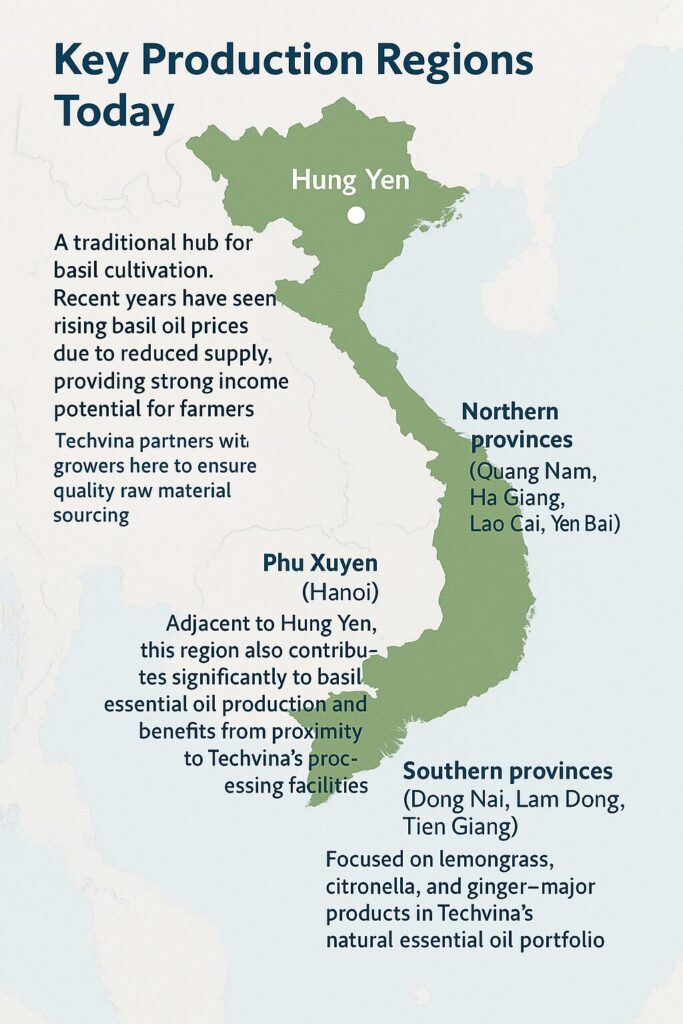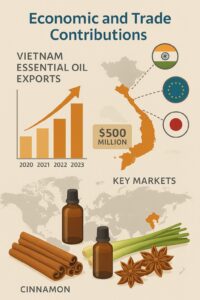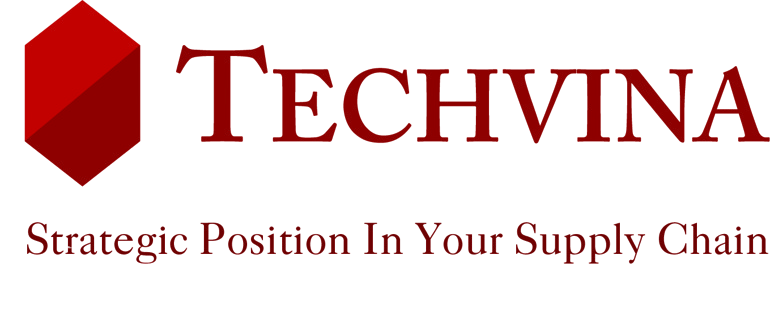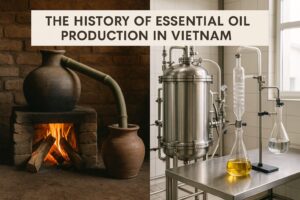Vietnam’s essential oil industry is gaining international recognition, thanks to its rich biodiversity, traditional cultivation methods, and increasing global demand for natural products. This article explores the factors contributing to Vietnam’s emergence as a key player in the global essential oil market.
1. Introduction
1.1 Global Rise in Essential Oil Demand
The global essential oils market is experiencing significant growth, driven by increasing consumer preference for natural and organic products. According to a report by Fortune Business Insights, the market is projected to reach USD 33 billion by 2029.
1.2 Vietnam’s Emergence as a Key Player
Vietnam has become a notable contributor to this market, particularly in the production of cinnamon essential oil. The country’s favorable climate and traditional farming practices have positioned it as a reliable source of high-quality essential oils, especially in cassia oil and its isolates.
1.3 Purpose and Scope of the Article
This article aims to highlight Vietnam’s natural advantages, key products, economic contributions, challenges, and future prospects in the Vietnamese essential oil industry.
2. Vietnam’s Natural Advantages in Essential Oil Production
2.1 Favorable Climate and Geography
Vietnam’s tropical and subtropical climate provides ideal conditions for cultivating a variety of aromatic plants. Regions such as Yen Bai, Lao Cai, and Quang Nam Province are known for their abundant growth of cinnamon, lemongrass, and star anise.

2.2 Rich Biodiversity and Native Species
The country boasts over 4,000 species of medicinal and aromatic plants. Notably, Quảng Nam is renowned for its Trà My cinnamon, or Saigon cinnamon, which has one of the highest essential oil contents globally.
2.3 Traditional Farming and Indigenous Knowledge
Vietnamese farmers employ traditional cultivation and distillation methods passed down through generations. These practices contribute to the unique aroma and chemical composition of oils such as organic cinnamon essential oil.
3. Key Essential Oil Products and Global Demand
3.1 Cinnamon Essential Oil
Vietnam is among the top three exporters of cinnamon globally. Essential oil extracted from Vietnamese cinnamon is widely used in food, cosmetics, and pharmaceuticals. Techvina, for example, offers high-purity cassia oil for global distribution.
3.2 Lemongrass, Star Anise, and Other Oils
Lemongrass is extensively cultivated in central and southern Vietnam, while star anise is a major export item due to its high shikimic acid content. These oils are used in everything from perfumes to antiviral drugs like Tamiflu.
>> You can explore Techvina’s natural essential oils for more.
3.3 Global Market Applications
Vietnamese essential oils are exported to major markets such as the United States, the EU, Japan, and India. Their applications span aromatherapy, personal care, and natural medicine.
4. Economic and Trade Contributions
4.1 Export Trends and Revenue
Vietnam’s essential oil exports have shown consistent growth. According to VietnamPlus, cinnamon and star anise exports exceeded $500 million in 2023, with the US and India as key markets.

4.2 Employment and Rural Development
The essential oil industry plays a vital role in rural economic development, especially in mountainous provinces. It supports thousands of small-scale farmers and local cooperatives.
4.3 Trade Agreements and Policy Support
Vietnam’s participation in free trade agreements like the CPTPP and EVFTA has helped streamline essential oil exports and reduce tariffs, boosting global competitiveness.
5. Challenges and Opportunities
5.1 Technological and Infrastructure Limitations
While Vietnam has traditional expertise, many small producers still rely on basic distillation methods. Investment in modern extraction systems is necessary to improve yield and meet global quality standards.
5.2 Regulatory and Certification Barriers
Obtaining certifications such as Organic, GMP, or ISO remains a challenge for smaller firms. Support in meeting these requirements could help open new markets and secure better pricing.
5.3 Environmental Sustainability
Overharvesting of aromatic plants like cinnamon threatens long-term sustainability. Adoption of organic farming and reforestation practices, like those promoted by Techvina’s organic initiatives, is essential.
5.4 Investment and Value Addition Potential
Vietnam has an opportunity to grow by expanding into value-added products such as oil blends, personal care products, and aromatherapy solutions—areas that are underexploited despite high demand.
6. Future Outlook for the Vietnamese Essential Oil Industry
6.1 Innovation and R&D
Research and development can improve extraction techniques and expand product applications. Collaborations between research institutes, industry stakeholders, and companies like Techvina will drive this innovation forward.

6.2 Vietnam’s Role in the Global Supply Chain
Vietnam is steadily evolving into a major global supplier of sustainable essential oils. With consistent quality and competitive pricing, it can compete with giants like India and Indonesia.
6.3 Strategic Roadmap and Industry Vision
Developing a national brand for Vietnamese essential oils, supporting local producers, and promoting traceability will be key to long-term success in international markets.


